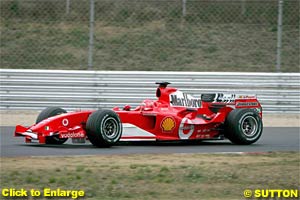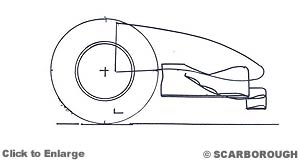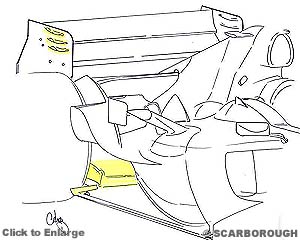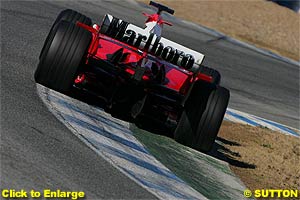
Atlas F1 Technical Writer
How does Ferrari plan to continue the astonishing run of success they have enjoyed against an ever-stronger field? By adapting to world-beating F2004 to the new regulations and racing it while they iron out the creases in their new challenger. Atlas F1's Craig Scarborough offers a full analysis of the F2004M, and contemplates where the Italian team can go from there
Last Year
But the car had all the right revisions to improve it over the compromised F2003GA – the wheelbase was shortened and the weight distribution was corrected, their main bug bear of cooling was resolved with the Imola update, and all the detail parts around the car were updated, with the resultant car optimised and mated well to its tyres. There is a strong belief that that the Bridgestones were inferior to Michelin in 2004, and yet Bridgestone made a tyre, for Ferrari at least, that reflected Michelin's 2003 hot weather performance and all round durability just as Michelin went the other way on performance and degradation.
Ferrari's main rivals in 2004 proved to be the outsiders, BAR and Renault, as Williams and McLaren had packages with fundamental problems. Once the championships were won there was an erratic period from the team, when the car was prone to spinning in the wet opening laps of the late season races and struggled to pass their rivals. There has been a lot of speculation that the car suffered more than most in traffic, and this is partly borne out by the teams qualifying strategy and willingness to follow up to the first stint.
Notwithstanding all of this, the F2004 was on the pace from its first session in Melbourne, and never saw a mechanical retirement all season - accident damage forced their two retirements.
This Year
With the F2004 car still operating above its competitors at season end, and major rules changes announced late in the year, Ferrari have decided to follow their recent tradition of releasing their new car late and running an interim car in the opening races.
There is no right or wrong approach to this strategy, although most of the other teams are going to race new cars at Melbourne, but Ferrari has pace in hand and the resources to build an effective interim car while still developing the new one, meaning their approach is less risky compared to the others. Of course, should the new teams leapfrog Ferrari on pace then the risk doesn't pay off, and Ferrari will be in trouble after losing critical points in opening races.
Ferrari have their simulation programmes predicting what times the new car could produce compared to the interim car - it was with these statistics that the call was made at the end of last year. But, what benefits does the interim car bring Ferrari?
In some respects the interim car will be anything but an old car, although it will inevitably be named as such by the media. In order to maximise the cars potential, changes planned for the F2005 will make their way onto the interim car, while changes demanded by the rules will shape the car. The monocoque will superficially be the same but the lay up will be all new, both for added stiffness and lightness as well as to accommodate the FIA impact tests, including the harsh side penetration test. The monocoque will have undergone new impact tests to prove its legality to race in 2005.
F2005
Predicting how a new Ferrari will appear has been a gamble for many years - the recent line of cars have produced minor innovations but not the major step change everyone hopes for. This year Aldo Costa heads the design team, under the management of Rory Byrne - this change is part of Ferrari's plans for succession when the current management leave the team, but with Ferrari having nearly three months more design time than their rivals they could reasonably be expected to find bigger layout changes to optimise the car to the rules.
However, they may have already found that downforce losses are as easy to regain with a conventional looking car as with a more radical one. Major variations to the monocoque layout appear to have been avoided by the other teams, leaving Ferrari with the nose treatment and sidepods as the major areas to play with and detail aerodynamic devices to tidy up the remaining airflow. Its probably in the latter area Ferrari, like McLaren, will find some innovations.
Aerodynamics
Grabbing the headlines as one of the first strange aero appendages, the new front wing / nose cone combination breaks some new ground in Formula One. Raising the front wing reduces its ability to produce efficient downforce, yet the 50cm window in the middle of the wing is still allowed to be a floor level. Making the most of the area means a wing with a long chord and deep camber; this makes the wing more sensitive to stalling.
There are many ways to prevent the separation that creates the stall; Ferrari has tackled this problem using two of the most common methods. Firstly the wing has three elements as allowed within the rules, with the extra slot speeding the flow under the following flap. Then they have also found a window in the bodywork regulations that sits ahead of the front wing. The FIA lay out boxes where bodywork (including wings) can and cannot exist; the front wing sits in its own box, but is behind an area still allowed for maximum overhang. It is this small remaining box of overhang that Ferrari has used for the chin wing.
This wing sits low and just ahead of the front wing, and works much like the mid and shelf wings do ahead of the rear wing - rather than acting as a wing in its own right, it acts as a flow conditioner for the underside of the front wing. The two elements squeeze the onset flow, speeding it up as it passes under the front wing's centre section, similar to leading edge slats on an aircraft wing. As the flow has more energy the wing has less likelihood to stall, can produce a higher pressure differential, and therefore more downforce.
The bargeboard arrangement carries over from the F2004, with two smaller boards either side of a larger one running a jagged footplate. From there the flow passes around sidepods largely carried over form the older car, already deeply undercut with a slim bottle shaped area. Some detail has been changed; the winglet and flip up now carry a small tapered gurney flap to help spin the untidy flow away from the rear wing. As per last year, mid and shelf wings precede the rear wing, albeit changed in detail with the mid wing being narrower and with the engine cover undercutting the shelf wing.
This undercut is not aerodynamically significant, but it is the first time a team have circumvented the 2004 bodywork rule demanding bodywork meeting a line running up the back of the car. The rules don't demand that the bodywork be continuous, and the gap under the wing is fully legal.
Ferrari have formed their endplates using a less literal interpretation of the dimensions, ending up with a smaller endplate than most teams. They have however copied an idea from Toyota, later adopted by Williams, with slits on the front part of the endplate - these bleed air from inside the endplate to reduce the vortices created at the wingtip, therefore reducing drag.
Making up for the downforce lost by the lower diffuser, Ferrari have also adopted the common practice of making the first gradient of the diffuser aggressively steep; with a simple treatment of the floor around the rear wheels, only a very large gurney flap running across the top of the outer diffuser tunnels could be considered unusual.
Mechanicals
For 2005 engines now have to last two race distances; Ferrari are once again supplying Sauber with the same engine as their own. As there has not been a definitive answer from Ferrari on which engine will run in the interim car, I would guess that the new double race life engine will have to be fitted, in order to ensure reliability over the extra 800 km. Similarly there was no confirmation if a new or old gearbox unit will be installed.
After continuous seasons of success, Ferrari has approached the new rules in a pragmatic way, adopting an old philosophy of running an interim car while the new car is developed. Ferrari is set to have a, for them, low key launch just before the start of the new season, and the interim F2004M has been rolled out without press announcement and little fanfare. As the interim car will possibly race up to the Spanish GP, we have looked at the car and detailed the changes made to the championship winning F2004.
 There's not a lot left to be written about the F2004 and Ferrari's season. After struggling to win the title with the F2003GA, most observers believed the conservative development of the car over the winter would prove to be insufficient against the much revamped Williams and McLaren challengers, and at first glance of the F2004 you would be mistaken for believing they were right.
There's not a lot left to be written about the F2004 and Ferrari's season. After struggling to win the title with the F2003GA, most observers believed the conservative development of the car over the winter would prove to be insufficient against the much revamped Williams and McLaren challengers, and at first glance of the F2004 you would be mistaken for believing they were right.
 The engine will now need to last two races, and the gearbox, electronics and suspension will all be upgraded, leaving very little untouched from the F2004. Only the major items on the layout and packaging will remain, providing the resemblance to the old car.
The engine will now need to last two races, and the gearbox, electronics and suspension will all be upgraded, leaving very little untouched from the F2004. Only the major items on the layout and packaging will remain, providing the resemblance to the old car.
 At first glance the F2004M appears the same as the F2004 raced in 2004, albeit adapted to the new rules. With the raised front wing and re-sited rear wing as the main giveaways, but there are a lot more detail changes than first meet the eye, proving Ferrari have paid some serious attention to this car.
At first glance the F2004M appears the same as the F2004 raced in 2004, albeit adapted to the new rules. With the raised front wing and re-sited rear wing as the main giveaways, but there are a lot more detail changes than first meet the eye, proving Ferrari have paid some serious attention to this car.
 The rest of the front wing bears resemblances to the Hungary wing seen last year; the centre section is curved downward, while the outer tips flick up with the trailing edges retaining the jagged cut outs rather than one long chord along its length. The wing is mated to a new nose cone with a distinct bulge to its underside, squeezing the flow between the nose and wing; this is similar to a shape run by BAR after the last front wing ride height change.
The rest of the front wing bears resemblances to the Hungary wing seen last year; the centre section is curved downward, while the outer tips flick up with the trailing edges retaining the jagged cut outs rather than one long chord along its length. The wing is mated to a new nose cone with a distinct bulge to its underside, squeezing the flow between the nose and wing; this is similar to a shape run by BAR after the last front wing ride height change.
 While the aerodynamics are clear to see, the lack of information coming from Ferrari makes assumptions on its mechanical set up hard to make. No doubt the suspension and traction control have been revised to take greater care of the tyres, so as to last a full race distance. As previously mentioned the monocoque will have had to undergo impact tests to prove the new lay up is as safe as their competitor's new cars.
While the aerodynamics are clear to see, the lack of information coming from Ferrari makes assumptions on its mechanical set up hard to make. No doubt the suspension and traction control have been revised to take greater care of the tyres, so as to last a full race distance. As previously mentioned the monocoque will have had to undergo impact tests to prove the new lay up is as safe as their competitor's new cars.
|
Contact the Author Contact the Editor |
Please Contact Us for permission to republish this or any other material from Atlas F1.
|
Volume 11, Issue 6
Articles
Technical Analysis: Ferrari F2004M
Technical Analysis: Red Bull RB1
2005 SuperStats: Winter Testing
The Fuel Stop
Regular Columns
The F1 Trivia Quiz
Bookworm Critique
On the Road
The Weekly Grapevine
> Homepage |